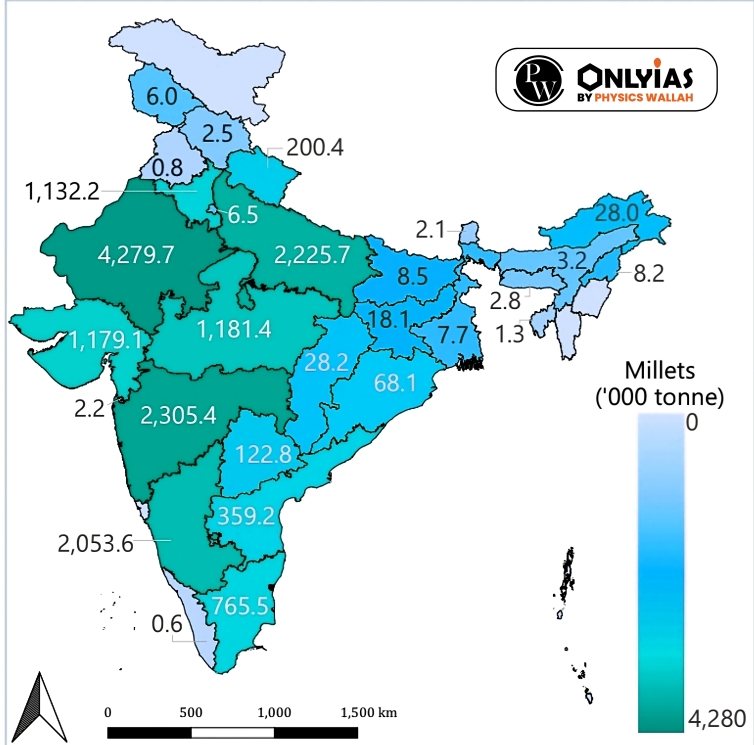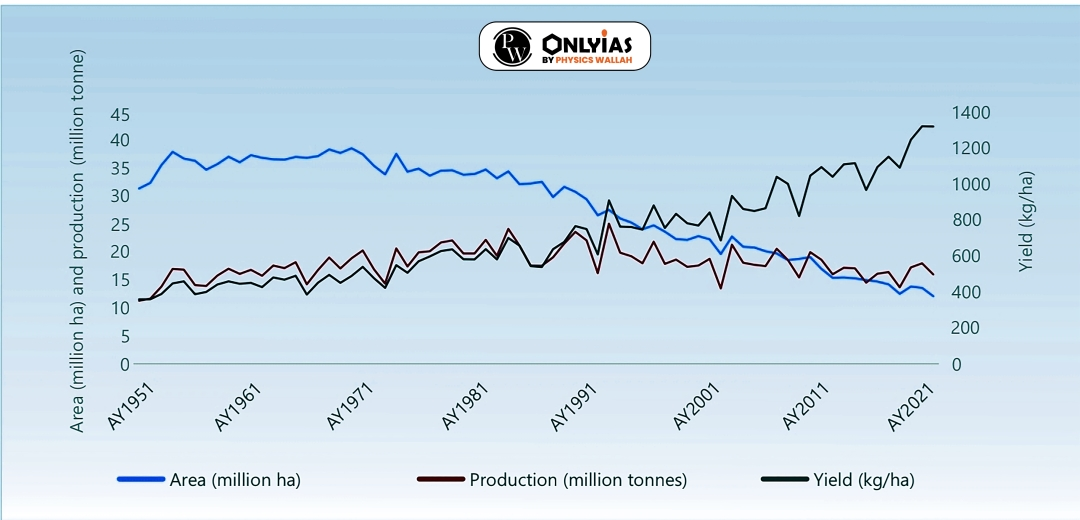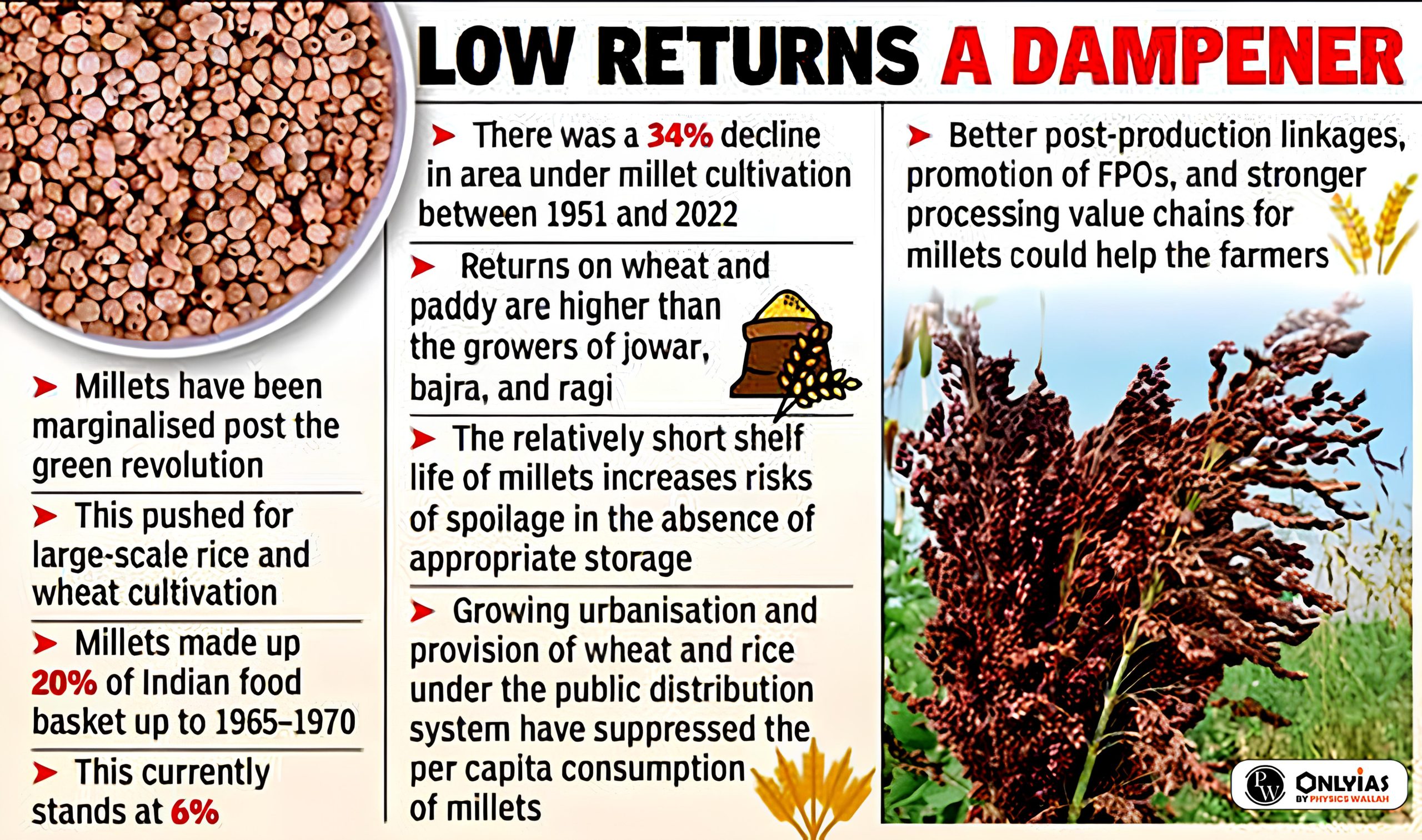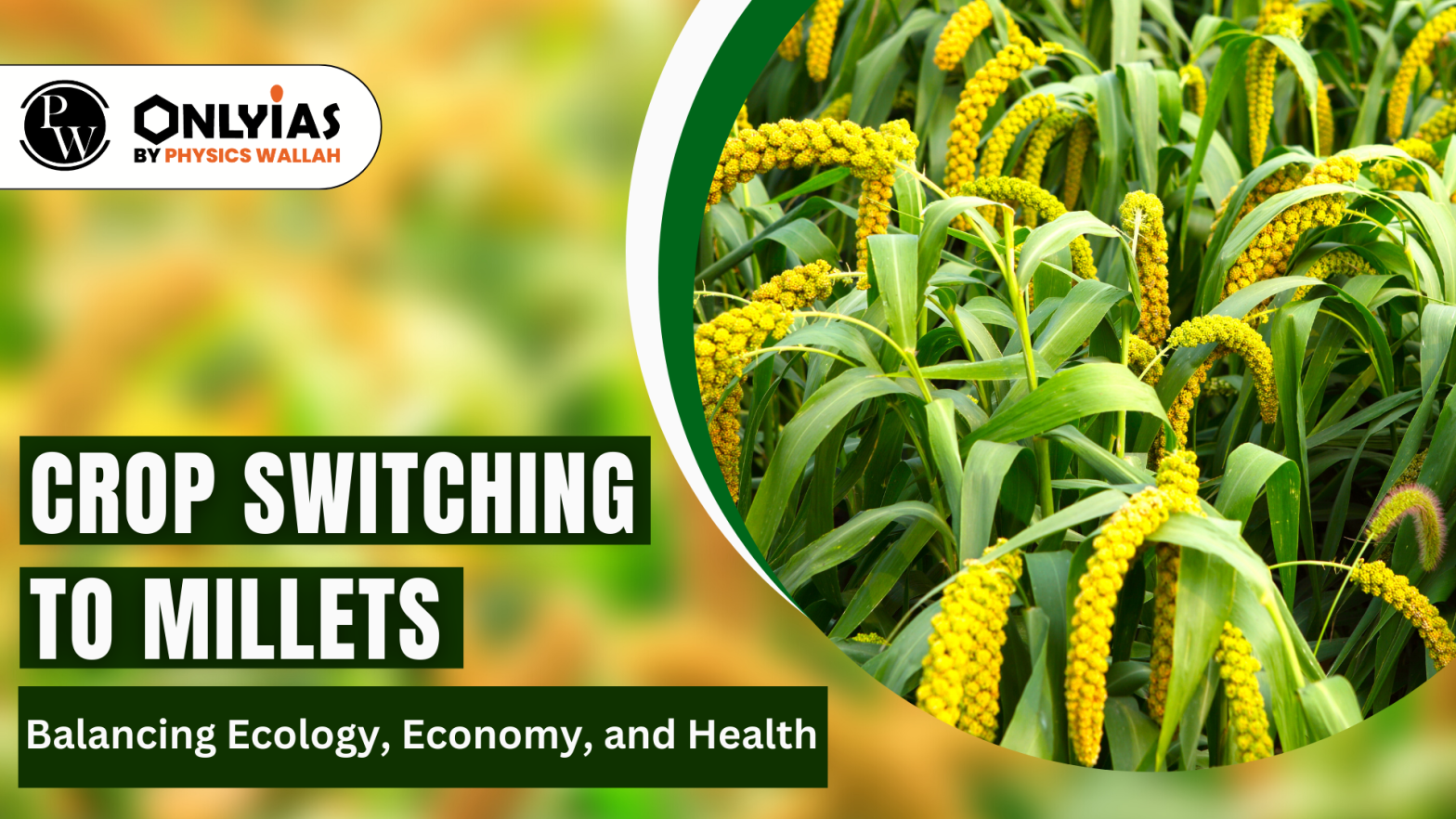Context:
Crop Switching: A Path to Sustainable Agriculture
- The government has branded the grain ‘Shree Anna’, featuring it in menus across events such as the G20 summit, while the United Nations has designated 2023 as the Year of Millets.

- The Ganga basin has seen a significant groundwater depletion in recent years, raising questions about the sustainability of present agricultural practices.
- Crop switching has garnered increasing attention as a viable solution to tackle the issue of unsustainable water consumption.
- However, its potential to produce co-benefits or trade-offs for other dimensions of sustainability i.e., food supply and farmers’ profits remains largely unquantified.
What are the benefits of millets cultivation?
- Ecological Benefits:
- Water savings: Crop switching to millets lead to reduction in groundwater depletion and energy savings with.
- With crop replacement, there could be 55 per cent and 9 percent water savings in the Kharif and Rabi seasons, respectively compared with present practice.
- A combination of crop switching and drip irrigation reduced groundwater depletion by 78 per cent.
- A study on water productivity mapping of major Indian crops indicates that rice, wheat, and sugarcane consume 80% of the freshwater available in India.
- Drought resistant: Millets are hardy, low-cost, and climate- and drought-resilient crops.
- They require less water compared to many other crops, positioning them as a sustainable choice for agriculture in arid and semi-arid regions.
- Climate change: As native crops, they are ideal for farmers affected by climate change. Because they grow on arid terrain.
- Economic Benefits: The increases in farmers profit from the crop switching are 139 per cent and 152 per cent for the Kharif and Rabi seasons, respectively.
- Therefore, millet farming, besides conserving biodiversity and water use, also supports the most vulnerable of food growers such as women, tribal, small, and marginal farmers.
- They can be grown in dry land areas using farmyard manures, thus reducing the dependence on synthetic fertilisers.
- Health and Nutritional Benefits: Shifting from the rice–wheat system to nutri cereals provides more micronutrients and proteins than rice and wheat.
- Millets are called Nutri-cereals and Superfoods because they are rich in niacin, zinc, and Vitamin A.
- This combination is especially helpful in treating skin disorders, acne, and hormonal issues.
- Including millet in diet can contribute to managing diabetes, lowering cholesterol, aiding weight management, and promoting digestive health.
What are the Millets/Nutri-cereals/Superfoods?
- Definition: Millet is a collective term referring to a number of small-seeded annual grasses that are cultivated as staple crops in semi arid regions of Africa and Asia.
- Major millet varieties include sorghum (jowar), pearl millet (bajra), and finger millet (ragi/mandua)
- Minor millets encompass foxtail millet (kangani/kakun), proso millet (cheena), kodo millet (kodo), barnyard millet (sawa/sanwa/jhangora), little millet (kutki)
- Pseudo millets—buckwheat (kuttu) and amaranthus (chaulai).
Climatic conditions
- Millets are primarily a kharif crop in India, predominantly cultivated in rainfed conditions, requiring less water and agricultural inputs than other staple crops.
Largest producers States in India
- According to the latest NABARD report, millet cultivation is prominently concentrated in Rajasthan (35.5%), Maharashtra (20%), Karnataka (13.3%), and Uttar Pradesh (8.8%).
Largest Productivity in India
- Andhra Pradesh stood in the first place in the country in millet productivity in 2022, as per the National Bank For Agriculture And Rural Development (NABARD) annual report 2022-23.

Largest producing country:
- India is the largest millet producer in the world, with a share of 44%, followed by China (~9%) and Niger (~7%).
- India produces 80 per cent of Asia’s and 20 per cent of the globe’s production that is led by Africa and the Americas.
- India is the second-largest exporter of millets.
|
Also read: Food Processing Industry In India
What are the challenges associated with Millet cultivation?
- Demand side issue: Taste perceptions, reduced per capita consumption due to urbanization and longer preparation times are the biggest barriers in millets consumption.
- Supply side issues: Relatively low-profit margins, guaranteed minimum support price (MSP) for wheat and rice, short shelf life leading to spoilage concerns, and public distribution of wheat and rice.
- Low yields: Compared to wheat, rice and maize, millets have lower productivity due to their cultivation in marginal lands in rainfed farming and non-adoption of improved cultivars.
- While wheat and rice yields are 3.5 tonnes and 2.8 tonnes per hectare, respectively, average yield for millets is 1.3 tonnes per hectare.
- Bringing the additional lands under millets cultivation is an important factor in increasing the production, especially the fallow and wastelands and the non-traditional areas.

- Poor shelf life: The relatively short shelf life of millets increases risks of spoilage in the absence of appropriate storage.
- Minimum support price (MSP): The low margins associated with millet production are exacerbated by the guaranteed MSP for wheat and rice, vis-à-vis other crops, creating disincentives.
- As a result, millets, which made up 20% of Indian food basket up to 1965–1970, stand currently at 6%, with a 33.9% decline in area under millet cultivation between AY1951 and AY2022.
- Infrastructure and value chain: The infrastructure for millet cultivation, processing, and marketing is often inadequate, particularly in rural areas.
- The arduous nature of initial millet processing has led to a notable decline in millet consumption within the nation.

What initiatives has the government taken to promote millet production?
- Global Millets (Shree Anna) Conference: To stimulate the exports of millets from India and provide market linkage to the producers.
- Millet International Initiative for Research and Awareness(MIIRA): It aims to connect millet research organisations across the world while also supporting research on these crops.
- GST on millets: Food preparation of millet flour containing at least 70 per cent of composition by weight, will have nil GST when sold loose without branding.
- The tax on millet flour containing at least 70 per cent millets, will attract zero per cent GST if sold loose, and 5 per cent if sold pre-packaged and labelled.
- Nutri Cereals Export Promotion Forum: It has been created by the Agricultural and Processed Food Products Export Development Authority (APEDA)to give export impetus and remove supply chain bottlenecks for millet start-ups.
- Raichur Declaration: The conclave initiated by NABARD outlined a series of commitments like enhancing production and productivity of millets.
- Millet Challenge: Through the Atal Innovation Mission, it aimed at addressing value chain challenges.
|
Way Forward
- Quality inputs: This entails providing quality seeds, with better efficiencies in processing so that the recovery improves from about 55 per cent in the case of minor millets to over 70 per cent.
- With proper crop management practices and seed improvements, yields up to 2.2 tonnes per hectare have been recorded in the case of finger millet (ragi) in Karnataka.
- An MSP for minor millets could be considered, backed up by procurement and marketing infrastructure.
- Millet FPOs: For farmers to realise higher prices for millets, better post-production linkages, promotion of farmer producers’ organisations (FPOs) and stronger processing value chains for millets are needed.
- Dharmapuri District Minor Millets Farmer Producer Company (Tamil Nadu) is involved in the value addition of millets in the brand name of ‘DMillets’.
- Focus on women and indigenous communities: Awareness among women and tribal farmers could help to achieve national goals of millet output and global goals related to sustainable agriculture, production, and consumption.
- Odisha Government’s five-year ‘Millet Mission’ is supplementing the input as well as marketing needs of indigenous small and marginal farmers like the Dongria Kondhs.
- Women millet farmers in rain-fed areas have to be empowered through capacity-building and skills
- Diversification of the PDS basket: It would improve prices of millets and, in turn, encourage the diversification of cropping patterns.
- Millets are a storehouse of nutrition and their inclusion in the Public Distribution System (PDS)could be beneficial for both the PDS consumers and millet growers.
- Strategic marketing and export promotion: There is a need for linking small and marginal millet farmers to online marketing platforms, such as e-NAM.
-
- A synergistic framework could be developed to study the market segments and map emerging food trends to top importing countries.
- Ex-India accounts for 40 per cent and 8 per cent, respectively, of the global output of bajra and jowar.
- Thus, India can create an export impact in bajra, ragi and minor millets as sorghum is produced globally.
- Research and development: Prioritising research in low-value cereals and developing sustainable production strategies can help address food and nutritional security concerns of millions.
- It is important to design and manufacture machinery that can enhance millet dehulling without compromising the nutritional value.
Conclusion
Switching to millets presents a promising solution for sustainable agriculture, offering ecological benefits like water savings and climate resilience, economic gains for farmers, and enhanced health benefits. However, addressing challenges such as low yields, shelf life issues, and market access are crucial.
| Attempt the PY Prelims Question
With reference to ‘Initiative for Nutritional Security through Intestive Millets Promotion’, which of the following statements is/are correct?
1. This initiative aims to demonstrate the improved production and post-harvest technologies, and to demonstrate value addition techniques, in an integrated manner, with cluster approach.
2. Poor, small, marginal and tribal farmers have larger stake in this scheme.
3. An important objective of the scheme isto encourage farmers of commercial crops to shift to millet cultivation by offering them free kits of critical inputs of nutrients and microirrigation equipment.
Select the the correct answer using the code given below.
(a) 1 only
(b) 2 and 3 only
(c) 1 and 2 only
(d) 1, 2 and 3
Ans: (c) |
![]() 13 Oct 2023
13 Oct 2023




